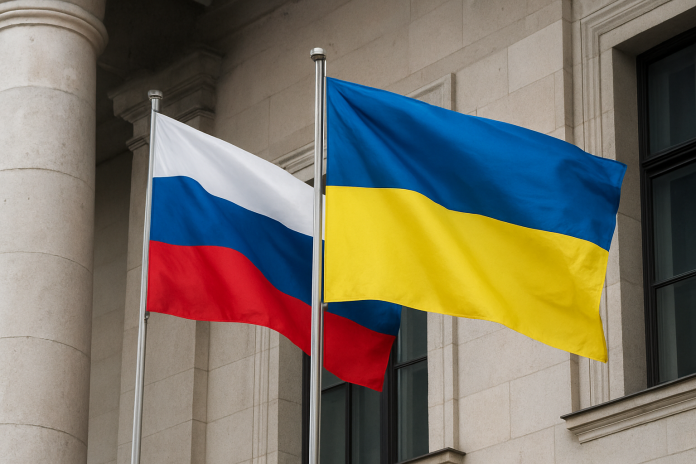Ukraine has raised serious concerns about how frozen Russian assets are being discussed in global peace efforts.
Russia’s Frozen Assets Spark Tension in Peace Talks
These assets, worth around $300 billion, were frozen by Western countries shortly after Russia began its full-scale invasion.
Ukrainian officials say these funds should only be used to support Ukraine. They warn that keeping these assets locked away forever or offering them as a negotiation tool could drag out the war even longer.
According to Kyiv, the idea of sharing part of these frozen funds between Russia and another major power as part of a peace plan is completely unacceptable. They insist that this money is tied directly to the damage caused by the invasion and must be used to help Ukraine rebuild.
Last month, European leaders failed to agree on a major financial plan known as a “reparations loan.” This plan would allow Europe to lend Ukraine money now, backed by the value of Russia’s frozen central bank reserves. Some countries were hesitant, but Ukraine says this loan is urgently needed.
West blocks SWIFT — Russia unleashes a secret fintech war to keep its money flowing
A peace proposal with 28 points, drafted without the involvement of European nations, suggested that some frozen Russian assets could be placed into a joint investment project between Russia and the United States. Ukrainian leaders strongly disagreed with this idea, saying it would violate basic legal principles.
A new peace proposal, updated with European and Ukrainian input, appears to have removed references to the frozen assets. However, it is not yet clear whether the assets might still be discussed behind the scenes as part of a final peace agreement. Ukraine has refused to comment on that detail.
For Kyiv, the position remains firm: the frozen Russian funds legally belong to Ukraine because they are linked to the damage caused by the invasion.
Europe Struggles Over Loan Plan as Ukraine Faces Funding Crisis
Ukraine’s financial situation is becoming extremely difficult. Support from the United States has stopped under the current administration, leaving Ukraine almost completely dependent on Europe for both money and military aid.
According to a letter sent by the head of the European Commission to EU member states, Ukraine will need enormous support over the next two years. The country requires more than 83 billion euros in military help and over 52 billion euros to cover basic government and financial needs.
Europe is considering three different options to support Ukraine. Out of these, the reparations loan backed by Russia’s frozen assets is seen as the most realistic choice for many EU countries. Several European nations are dealing with their own financial problems, making it harder for them to send huge amounts of money directly from their budgets.
Ukrainian officials say this loan is essential. They argue that if Europe uses the reparations loan, Ukraine would finally have reliable long-term support, helping it continue defending itself without being forced to make urgent financial appeals each month.
Europe holds the largest portion of Russia’s frozen money. Belgium alone controls around 185 billion euros of the reserves stored in European financial institutions. For Ukraine, this amount represents a powerful tool that could push Russia to end the war.
Inside Ukraine’s parliament, lawmakers say that European diplomats have recently expressed doubts about what more they can do to pressure Russia. Ukrainian officials respond that the frozen assets remain the most effective way to influence the situation.
Russia’s Frozen Assets Seen as Key to Ending the Conflict
Ukraine believes that frozen Russian assets represent one of the strongest forms of leverage available to the international community. These funds were locked away by Western countries after the invasion began, and are part of a larger pool estimated at $300 billion.
The World Bank says that Ukraine needs more than $524 billion to repair the damage caused by nearly four years of full-scale war. Homes, roads, schools, hospitals, and entire communities have been destroyed or severely damaged.
Because of this, Ukraine argues that using the frozen Russian funds is not only legal but necessary. Ukrainian officials say these funds were created through the same state structures that ordered and supported the invasion. For Kyiv, this is why the assets cannot be handed back or treated as a negotiation token in peace talks.
India’s discounted Russian oil imports come to an end with upcoming sanctions
Some early peace proposals suggested dividing or redirecting these assets, but Ukrainian authorities have rejected any such ideas. They emphasize that the frozen funds must be used for rebuilding the country and supporting people affected by the war.
European countries continue to debate how to move forward with the reparations loan proposal. Ukraine, however, says the choice is clear. The country insists that Europe must use these frozen assets to help maintain Ukraine’s financial stability, supply essential services, and support its defense needs.
As questions remain about the latest version of the peace deal being discussed, the future of Russia’s frozen assets has become one of the most important and sensitive topics in international diplomacy. Ukraine continues to stress that these resources are central to ending the conflict and supporting the country’s recovery


